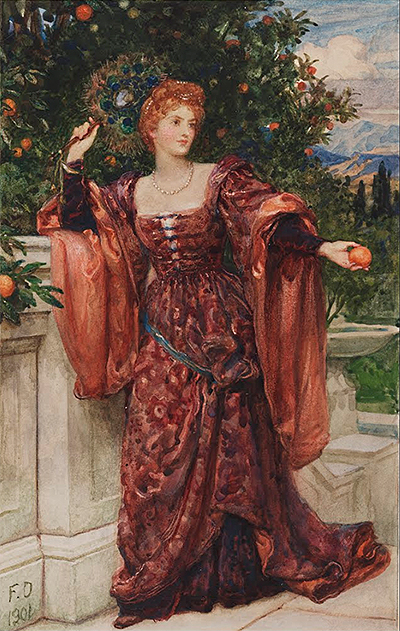Hesperia by Frank Dicksee was painted in 1901 and depicts one of the immortal sisters from the Greek mythological story of the Hesperides. Sometimes known as the 'red one', Hesperia and her sisters were nymphs, charged with guarding an orchard of golden apples around which a fearsome dragon also roamed.
It was said in legend that when eaten, these apples would grant eternal life. The story is highly romantic and fits well with Dicksee's other works as a dramatic literary and historical painter. The painting of Hesperia is done in watercolour and is actually a smaller representation from a larger work that Dicksee exhibited in 1887. Despite the Greek mythological origin of the story, Dicksee paints Hesperia as very much a Pre-Raphealite beauty, with her heavy corseted gown and Edwardian hairstyle rather out of place in a Greek garden of the gods. Her face is exquisitely delicate, with porcelain skin and rose bud lips, perfectly in keeping with Dicksee's style of romanticising historical characters and figures.
The painting depicts Hesperia taking an apple from one of the trees with one hand as she cools herself with a fan made from peacock feathers in the other. Dicksee was famous for his portraits, with fashionable women of the era often engaging him to capture them on canvas, and this painting of Hesperia certainly fits with this catalogue of his work. As well as her fashionable attire and alluring figure, Hesperia herself is very sensuous and rather looks as if she may be tempting someone to take the apple from her hand. Dicksee was quoted as believing in 'heroic conquest, male dominance' and it certainly seems as if Hesperia is waiting for a visitor to the enchanted garden.
Singling Hesperia out in this way, rather than painting her alongside her sisters, also gives the painting echoes of Eve and the Garden of Eden. Frank Dicksee came from an artistic family, with his father and sister also painters, and he trained at the Royal Academy in 1870. He enjoyed much success right from the start of his career and was knighted for his services to art in 1925 by King George V. Although a celebrated portrait painter, Dicksee was also an illustrator and painter of famous historical scenes, focusing on themes of chivalry and romance.




